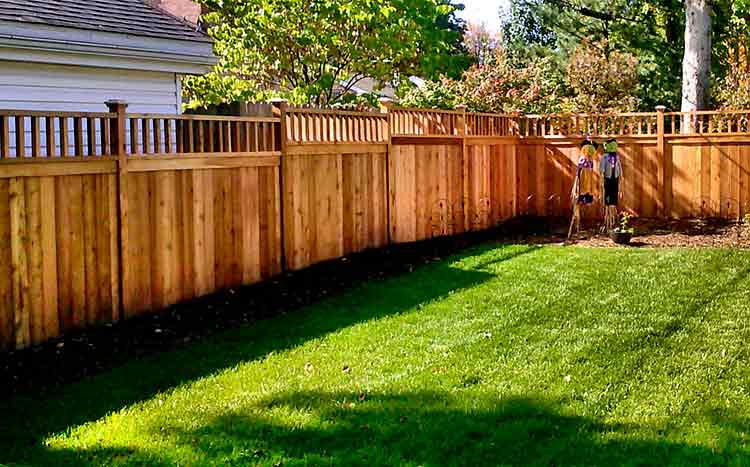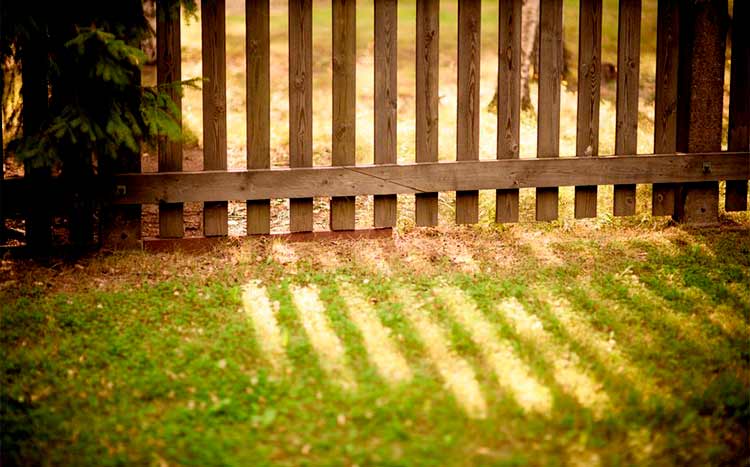Before you build a fence, it’s essential to understand the laws and regulations specific to Oregon regarding boundary fences and fencing overall. Acquiring this knowledge will help prevent disputes and ensure compliance with all relevant building codes and standards.
Adjoining landowners are required to share ownership of fences erected on the boundary line according to Oregon state property rights and transactions statutes Chapter 96 of 2019 on line and partition fences. An owner who erects a fence on the property line that doubly encloses their neighbor’s land has the right to compel them to pay half of its expenses.
What we cover
ToggleDo I Need A Permit To Build A Fence In Oregon?
You are required to apply for a building permit with the relevant offices in your area when building a fence taller than 7 feet in the state of Oregon. Local city, county, or municipality-level building and zoning requirements may be slightly different.
You will be required to provide a description of the fence proposed with specifications such as height, materials, and location of the fence as well as the contractor’s information. Permits are reviewed by an Oregon-certified plans examiner to ensure the fence meets local building codes.
Fence building permits can be obtained from your nearest building codes office, relevant city or town hall departments, or online depending on your location. Also, note that some cities or towns in the state of Oregon may have additional permit requirements and procedures.

Can I Replace an Existing Fence Without A Permit?
You do not require a building permit to erect a fence that does not exceed 7 feet in height in the state of Oregon. Permits are required to enlarge, alter or replace fences to ensure compliance with local building codes, safety standards, and zoning requirements if they exceed the legal height.
Note: Your contractor can provide crucial guidance or assistance on the permit requirements and also ensure that the new fence complies with existing laws.
How Tall Can A Privacy Fence Be in Oregon?
There is no statewide maximum fence height requirement in the state of Oregon. However, individual cities, towns, and counties in the state may or may not have fence ordinances that include allowed privacy fence height limits.
For instance, it is illegal to erect a fence taller than 7 feet in specific areas within the city of Portland, Oregon. The legal fence height is measured from the lowest grade at the base of the fence being constructed or altered.
The table below shows maximum privacy fence height limits from select cities and towns within the state of Oregon. Note that additional items such as trellises, lattices, posts, and decorations added to the top of a fence are considered when measuring the height.
| City/ Town in Oregon | Maximum Fence Height allowed (Feet) |
|---|---|
| Portland | 7- 8 Feet- Also depends on zoning rules and resident association rules. |
| Salem | 6 – Feet depending on the location of the fence. Check local fence ordinances. |
| Eugene, Oregon | 8 Feet- on front and interior yard setbacks. (Deer Fence) can be taller provided it provides a clear view through the fence. |
| City of Oregon | 3-5 Feet on front yards and up to 6 Feet in Rear Yards |
| Bend, Oregon | 3 ½ feet for front decks except for decorative arbors, gates, and similar features (6 Feet). 6 Feet on Rear yards. |
| Astoria, Oregon | 4 Feet on front yards and 8 Feet between properties for interior lots- 4 Feet for front yards and 6 Feet in rear yard for corner lots |
Note: Each city or town in the state of Oregon has similar or slightly different fence requirements as the ones highlighted in the table. Be sure to obtain a copy of the relevant local building codes specifically covering fences and similar structures when designing your new fence. Most licensed contractors in the state have copies of relevant laws with them and can help with compliance.
Who Owns the Fence on Property Lines In OR?
Fences sitting directly on the boundary or property lines are jointly owned by adjoining landowners according to Chapter 96 of Oregon’s property lines and transactions statute section 96.010 of 2019. Individual landowners who erect fences on property lines that are also beneficial to their neighbors have the right to ask them to pay half of the fence’s expenses.
The same statute under section 96.20 and section 96.40 also states that neighbors are responsible for the joint maintenance, repair, or improvement of a fence erected on the property line. You are allowed, under the law, to file a civil lawsuit in the case that the adjoining landowners neglect the fence.
Should you decide to repair the fence without your neighbors’ input, section 96.40 also allows you to recover half of the expenses from your neighbor.
How Do You Know Where the Property Boundary Is?
The easiest way to know where your property line is to do a professional survey of your land with the help of a licensed surveyor in the state of Oregon. A physical survey involves onsite measurement of your land and searching available land records at your local county or municipal surveyor’s office.
You can also identify property dimensions and property lines from existing plat maps if you live in a surveyed area. These plat maps can be obtained from your nearest lands or public survey office or online government portals where available.
Also, note that you may need the help of a licensed surveyor to properly interpret plat maps and land records.
Can My Neighbor Build A Fence On The Property Line?
Your neighbor has a right to build a fence on the property line according to Oregon boundary fence laws provided there is a need for the fence and it is built according to existing building standards.
The state statutes also allow the neighbor to recover half of the building expenses from adjoining landowners. However, both landowners have equal ownership rights to the property line fence.

Can I Put Up A Fence on My Side of The Property Line?
You are allowed to erect a fence on your side of the property line under Oregon boundary fence law. If the fence sits directly on the boundary/property line, then you can elect to share building expenses with adjoining landowners or recover half of the costs later. The fence belongs to you if it sits a few inches from the identified boundary and there is an empty unused space between your land and the adjoining lot.
Who Pays for A Fence?
Section 96.10 of the Oregon boundary fence law on sharing expenses of partition fences states that adjoining landowners should agree to share half of the cost of the boundary fence. This, however, applies if the boundary fence is deemed to benefit both of them in that it encloses their land or provides privacy.
What Happens If A Fence Is Built on The Wrong Side of a Property Line?
Building a fence on your neighbor’s land, otherwise referred to as encroachment, is covered under section 96.060 of Oregon’s boundary fence statutes. You are allowed under the law to demolish the fence within one year of discovering the mistake if it was built in good faith and by mistake. During this grace period, your neighbor is not allowed to demolish, tear down or disturb the fence in any way.
What Is A Spite Fence?
A spite is a fence that is an annoyance to adjoining landowners or undesirable in some way to them. For instance, the fence could be too tall, dense, and blocking a view or have dangerous components such as thorns, electrified wires, or spikes. Spite fences are a source of conflict for most neighbors and may be illegal in some cities.
Some cities such as Portland and Beaverton provide mediation services for landowners who have disputes over spite fences. You can also raise a private nuisance complaint or file a civil suit with relevant authorities if mediation does not work.
Oregon Boundary Fence Laws at A Glance
| Statues | Partition Fences: Shared Expenses | Partition Fences: Removal |
|---|---|---|
| Partition Fence; Shared expenses: Or. Rev. Stat. 96.010 Fence Removal: Or. Rev. Stat. 96.060 | Adjoining owners are responsible for shared expenses for partition fences; When the adjoining owners do not agree about the construction of the fence, the party that wants the fence may sue the other party for half of the actual construction and maintenance costs. | When a person builds a fence by mistake and in good faith, they must remove the fence within one year of the discovery of the mistake; The owner/occupant of the property where the fence has been built by mistake must not bother the fence during the time period when the other owner/occupant is authorized to remove the fence. |
FAQ's
What If A New Fence Is Blocking My View?
There are city and state-level building codes that specify the height and nature of residential and commercial fences. Some cities in Oregon also allow tall fences provided they provide a clear view through. Talk to your neighbor, file a private nuisance complaint or seek mediation if they erect a fence that blocks your view.
Can My Neighbor Hang Things on My Fence?
Your neighbor is not allowed to hang things on a fence that is sitting on your land. They can hang things on a shared property line fence as long as they are not visible from your side of the fence. Signing a property line usage agreement can help prevent such disputes.
Can I Paint My Side of The Fence?
Yes, you are allowed to paint your side of the fence as long as the fence is standing on the property line and shared. However, you should notify your neighbor of alterations that change the structure or nature of a shared fence to avoid disputes. You are not allowed to paint a fence built on your neighbor’s lot unless they give you permission to do so.
Can I Build A Fence Next to My Neighbor’s Fence?
Yes, Oregon boundary fence law section 96.40 on the removal of partition fences allows you to build a fence and leave an empty lane between the adjoining lots. However, you should notify your neighbor at least six months in advance of your intentions and ensure that you have identified the correct boundary line.
What If My Neighbor Doesn’t Repair Damage to Their Side of The Fence?
You are allowed under Oregon boundary fence law to ask or compel your neighbor to repair the fence or share repair costs. You can file a civil lawsuit if the said neighbor is not willing to comply and the courts shall award reasonable attorney fees to you if you prevail.
Can I Take Down an Existing Fence?
You are allowed under Oregon law to take down an existing fence if there is a need to do so. However, the statute requires you to notify your neighbor and agree before removing the partition fence.
Who Is Responsible for Gates?
Both landowners in adjoining properties where there is a gate exists are responsible for it under Oregon boundary fence law section 96.050 on gates and partition fences. If a person passing through the shared gate does damage to a property, they will be liable to the aggrieved party.














